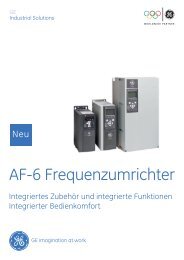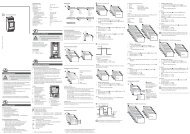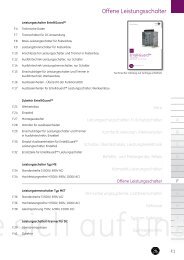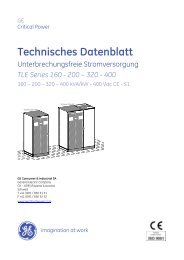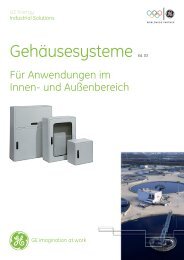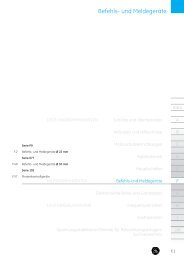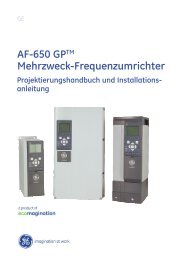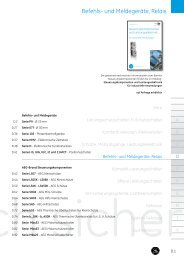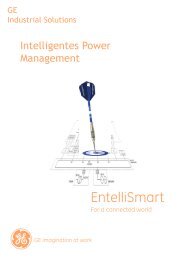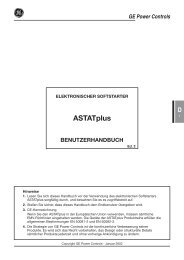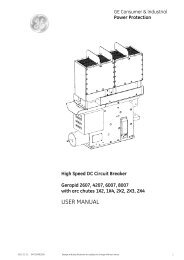Comfort Functions - GE Industrial Solutions
Comfort Functions - GE Industrial Solutions
Comfort Functions - GE Industrial Solutions
Create successful ePaper yourself
Turn your PDF publications into a flip-book with our unique Google optimized e-Paper software.
<strong>Comfort</strong> functions<br />
A<br />
B<br />
C<br />
D<br />
E<br />
F<br />
G<br />
X<br />
D.10<br />
Redline<br />
Function<br />
Impulse switches are electromechanically or electronically controlled<br />
switches used to control single- or multi-phase medium-power loads<br />
while the control itself can be (very) low power. The device switches<br />
between 2 stable positions, each time a (brief) impulse energises its<br />
control circuit.<br />
Applications<br />
Mainly used for the switching of lighting and heating equipment<br />
and/or to obtain a simplified wiring in case the load needs to be<br />
controlled at reduced voltage and/or from more than 4 different<br />
places.<br />
Features<br />
Besides the normal operation through electrically energising the coil,<br />
manual operation is possible at all times. The switch position of<br />
the impulse switch is visualised through an indicator flag for the<br />
EM-version, or through an LED for the electronic version. The central<br />
command version was developed to force several devices at the same<br />
time to the on or off position, independently of the current status of each<br />
individual device. Also in this case, the possibility of operating the device<br />
locally remains. The safety terminals are equipped with captive Pozidriv<br />
screws and have IP20 protection degree. An add-on auxiliary contact,<br />
add-on central-command module and a spacer are available.<br />
Standards<br />
Pulsar S<br />
IEC 60669-1, IEC 60669-2-2, BS EN 60669-1, BS EN 60669-2-2<br />
More technical data<br />
Dimensions<br />
website<br />
pg D.38<br />
Impulse Switches<br />
Performance<br />
Rated switching capacity<br />
Contacts<br />
Contact spacing / material<br />
Spacing between control and load circuit<br />
Isolation voltage contact/contact<br />
Isolation voltage contact/magnetic system<br />
Switching capacity<br />
Incandescent lamp load<br />
Fluorescent lamp load, lead-lag circuit<br />
Fluorescent lamp load, inductive or capacitive<br />
Fluorescent lamp load, parallel compensated<br />
Electronic ballast load<br />
Inductive load, cos ϕ = 0.6 at 230V<br />
DC switching capacity<br />
Minimum contact load<br />
Maximum switching frequency<br />
Mechanical service life<br />
Electrical service life, cos ϕ = 1 (1)<br />
Electrical service life, cos ϕ = 0.6 (1)<br />
Electrical service life, 1000W incandescent lamp (1)<br />
Screws<br />
Terminal capacity: min<br />
max<br />
Magnetic control system<br />
Control voltage range<br />
Relative duty at rated voltage 1&2-pole/3&4-pole<br />
Maximum continuous time of coil excitation<br />
Minimum duration of command impulse / pause<br />
Operating temperature range<br />
Maximum load of illuminated push-buttons<br />
- Without parallel compensating capacitor<br />
- With 1µF/250V capacitor parallel to coil<br />
- With 2.2µF/250V capacitor parallel to coil<br />
Maximum coil power loss at Un and In<br />
Maximum control line capacitance<br />
Screws<br />
Terminal capacity: min<br />
max<br />
(1) Guaranteed at maximum switching frequency.



